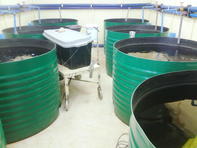
What is Tilapia?
Tilapia is the second most farmed freshwater fish species in the world. Originating from tropical Africa and the Near East, tilapia is an omnivorous fish (eats both plant and animal matter) that can sustain wide environmental conditions.
They can be commercially cultivated in a wide variety of warm water systems (20 - 30℃), but do best in ponds with abundant natural food.
Which Species of Tilapia is Best for Farming?
Some 95% of worldwide tilapia production uses improved strains of Oreochromis niloticus, the Nile tilapia. This species has superseded the formerly used O. mossambicus (Mozambique tilapia) which suffers the disadvantages of early maturity, slow growth and poor body shape, giving low fillet yields.
Disease resistant, deep-bodied and fast-growing strains of Nile tilapia are now the commercial standard, in both red and silver colour. (’Deep bodied’ means that the body is deep in profile, as opposed to one with a shallow body form, an excessively large head and no ‘meat’ like O. mossambicus.) Nile tilapia can grow from a 1 g fingerling to 500 g mass (market mass) in 8 - 9 months compared to up to 14 months for other tilapia species.
Nile tilapia are widely cultivated in Southern Africa but require a special permit from the Department of Environmental Affairs (DEA) in South Africa, where it is classified as an alien invasive species.
Growing Conditions for Tilapia
Tilapia is a warm-water species with optimal water temperatures in the range of 24 - 32℃. The growth rate of tilapia slows down when water temperatures are below 20℃ and it shows little to no growth below 15℃. Tilapia is more susceptible to diseases at low water temperatures (colder than 15℃) and will die at 12℃ or lower.
This restricts the areas in South Africa where this species can be grown commercially outdoors, although green-house tunnel-based culture allows for more widespread farming.
Although tilapia are more forgiving of low oxygen levels (lower than 4 ppm) and high ammonia levels than some other fish species (e.g. trout) growth is not successful when water quality is sustained at low levels. It is a mistake to believe that tilapia can be grown in poor environmental conditions.
Tilapia Production Regions in South Africa
Although warm water temperatures throughout the year are ideal, the high tilapia production of countries like Egypt (where more than 750 000 tons are produced annually) shows that areas of South Africa are also ideal for green water pond culture of tilapia.
Egypt, with its cool Mediterranean winters, has water temperatures as low as 10℃. There are many parts of South Africa’s northeast Lowveld (in both Limpopo Province and the Mpumalanga Province’s Incomati corridor) as well as in KwaZulu-Natal’s northern coastal region that have winter water temperatures above 150℃, making them ideal for outdoor tilapia culture.
Green Water Pond Systems for Tilapia
The bulk of tilapia farming in China, Indonesia, the Philippines, Bangladesh, Israel and Egypt is done in fertilized and fed green water ponds. ‘Fertilising’ of green water ponds is the addition of either animal or chemical fertiliser to the water to promote the growth of natural fish food - organisms like daphnia, cyclops and algaes that the fish feed on.
The water goes green during the process. In ‘fed’ green water ponds, artificial pelletized feeds are used. The system of green water ponds, reduces feed costs by promoting abundant natural food in the ponds. These ponds must be quite large to maintain good water quality, a size of at least 0.25 ha (e.g. 50 m x 50 m).
All tilapia fingerlings are selectively bred and all-male, preventing early over-population in the ponds. The old 1960’s system of small, clear water ponds, using mixed-sex fingerlings of unknown ancestry has long been discredited as worthless.
Re-circulating Systems for Tilapia
Re-circulating aquaculture systems (RAS) for tilapia farming have been tried in urban and semi-urban areas. However, the RAS system is energy and skill demanding and suffers the drawback of needing artificial feeding. In South Africa, tilapia feed is very expensive in comparison to countries such as Zambia.
With a food conversion ratio (FCR) of around 1:1.5 in good systems, using for example tilapia feed at R12/kg, feed costs alone can reach R18/kg in even the most productive RAS. These energy, skills and costs make the economic viability of RAS questionable.
Combined with high energy and labour costs, the cost of rearing tilapia in such systems can exceed the market price of tilapia meat at times.
Whilst RAS has the advantage of controlling water quality it must be accepted that the risks of system failure are high, with consequent stock losses. Such systems are energy dependent 24/7, requiring a reliable automatic back-up energy supply and a high level of technical skills. In addition, it is as yet unproven economically.
By Nicholas James